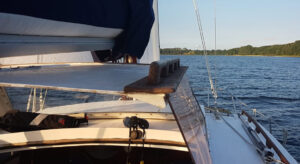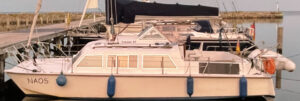Solar cells on board?
You come on board and need to charge your batteries?
You would like to anchor more and use your electric refrigerator?
You like sailing and therefore don’t want to use the engine just to have electricity?
For us, it was a combination of all three, coupled with the experience of our other boat, which has been sailing with solar backup for two years.
How did we arrive at our solution.
We encountered the following questions:
1) Where do we put the cells?
2) What type of modules will fit in what location on the ship?
3) Which battery do we charge and how is the supply on board at all?
4) Is the investment worth it?
Where do we place the cells?
Since we were looking for a solution for our Naos, we went through a few possibilities.
Think carefully about where the solar panels will not bother you and will be in good hands. The first idea was to use the huge hatch garage of the sliding hatch. This seemed and ideal until we observed that when we set and retrieve sails, we very often walk around on it and the garage would bend slightly, exposing the cells to regular movement. This is not a good idea even with modern modules.
The next idea was the surface of our doghouse (a fixed sprayhood). This is unfortunately also quite flexible and the installation of a module from the camping area seemed favorable, since eigendlich never someone on the Doghouse herumturnt. But then we noticed the risk of the big tree shaving off the module. Thus the choice of a rigid module fell into the water and for a flexible one the bends of the thin roof seemed too strong.

So our search starts.
Where do we have smooth surfaces that won’t be stepped on or won’t give way. Ideally both.
How about using the coaming with a wink of about 80 degrees? Is the efficiency still great enough at that angle? Are there modules that could fit in this shape? After all, the coaming is long and narrow?
Due to the tilt, we lose about 20-40% of the efficiency compared to a perfect orientation. We decided not to optimize the angle of incidence, since Naos is moving in all directions anyway. Because of the higher angle, the efficiency is better in the morning and evening hours. Maybe also in spring and autumn. A bet that worked out for us.
What kind of modules fit in which place of the ship?
In a catamaran fit rigid and thereby usually somewhat thicker modules on our roof or over the davids. These can not be stepped on. For mounting there are wonderful holders that are screwed to the substrate and fix the module.
In places that are not exactly straight, flexible or semi-flexible modules must be used. These are usually more expensive and in the case of the dandelion, we have experienced that they do not last long on a slightly flexible substrate. Therefore, a rigid place, for this is very useful, which is ideally not entered. The flexible or semi-flexible modules are glued to the substrate with the help of an adhesive compound and can only be removed again with great effort.
We have opted for the adhesive solution and are very satisfied with it.
What batteries do we charge?
Until now Naos had a port and a starboard battery as starter and consumer battery. This solution is simple and worked, but we always have the risk that the refrigerator discharges the starter battery so far that we can no longer start the starboard engine. Since we have a third battery on board, the circuits were separated so that the board consumers now have their own battery and the engines use their batteries alone. So it is obvious that we will only supply the consumer battery with solar energy.
If a separation seems too costly, take the battery that will supply most of the consumers, e.g. for the refrigerator or the navigation electronics.
If you are technically savvy and interested, make a list of the largest or even all consumers.
Is the investment even worth it?
Yes, for us it is worth it, we got through the entire first summer independent of outlets and every weekend we could start with fully charged batteries. Even the vacation weeks could be spent at anchorages and ports without a need to charge at the socket.
Our solution:
We have opted for large modules (*) on the outside of the coaming and thus installed a total of 160 Wp. We are doing very well with them despite a less than ideal angle and slight shading from railing supports.
(*)Affiliate: If you buy your solar panels through this link, we will receive a small support without any cost or disadvantage to you. Thank you very much.


